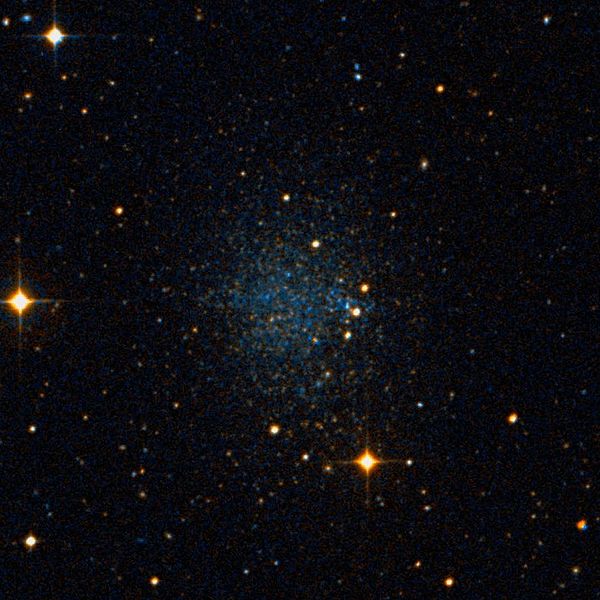Dwarf Galaxies from Primordial Clouds
Interview with
Chris - Scientists have discovered a new type of Galaxy. They've been using a NASA space telescope called GALEX - the galaxy evolution explorer which can see ultraviolet light. A team of US scientists have been studying a patch of the sky called the Leo ring. This is thought to be a leftover remnant from the Big Bang. It's basically a huge cloud of hydrogen and helium. What scientists saw in there were signs of newborn stars in little galaxy sized clumps inside that ring. To tell us why that's important and why they didn't see any dark matter to go with it here's David Thilker.
 David - What we've done is discovered a new, unexpected type of galaxy, a dwarf galaxy forming in the local universe. These galaxies are odd because they have apparently condensed from pristine gas without the help of dark matter anyway.
David - What we've done is discovered a new, unexpected type of galaxy, a dwarf galaxy forming in the local universe. These galaxies are odd because they have apparently condensed from pristine gas without the help of dark matter anyway.
Chris - Can you just explain that a little bit? When you say this is made from pristine gas, what do you mean by that?
David - In the universe today there are very few remnants of the material from which all other galaxies formed. The best known candidate for one of these pristine primordial clouds is the Leo ring. It's a structure 600,000 light years wide, consisting only of hydrogen and helium in a nearby galaxy group about 30,000 light years from us. Evidence is that this object has been around from the time that galaxy group formed and has been doing nothing ever since.
Chris - How have you tried to understand or to explore this distant mass of gas? What do you think it's been doing?
David - The GALEX satellite that I've been using, the Galaxy Evolution Explorer is a telescope in Earth orbit launched by NASA and the UK in 2003. We've been surveying the entire sky in ultraviolet wavelengths that are sensitive to the process of star formation. What happened was I was looking at a galaxy that was nearby this Leo ring. I knew this primordial cloud was in the field of view of this other galaxy. I thought, why not go ahead and see if we see any evidence for star formation. At that point it was possible to detect something.
Chris - Why do you need UV in order to do that? Why can't you just use normal light telescopes?
David - The UV is best for detecting star formation because the most massive stars are several times more massive than the sun, emit most of their light in the blue part of the spectrum. They stand out like a light post to the ultraviolet telescopes. Those stars are the most massive ones and live a very short lifetime. If you see them you know they've essentially just formed. It's a combination of the colour and the lifetime of the star that allows us to see star formation with the ultraviolet.
Chris - When you use the UV cameras like this to look at this distant entity what do you see and what is that telling you?
 David - When you look at the Leo ring in the UV wavelengths we have detected ultraviolet emission coming from clumps within the gaseous ring. Those clumps are much smaller than the size of the Milky Way galaxy, for instance. They qualify as dwarf galaxies. The interesting thing about this detection is that these radio observations, the same ones we used to discover the gas of the Leo ring, also indicated there was no dark matter within those clumps of the ring. You have this combination of ongoing star formation and no dark matter within a cloud of pristine gas. It's really something quite unique that hasn't been seen before.
David - When you look at the Leo ring in the UV wavelengths we have detected ultraviolet emission coming from clumps within the gaseous ring. Those clumps are much smaller than the size of the Milky Way galaxy, for instance. They qualify as dwarf galaxies. The interesting thing about this detection is that these radio observations, the same ones we used to discover the gas of the Leo ring, also indicated there was no dark matter within those clumps of the ring. You have this combination of ongoing star formation and no dark matter within a cloud of pristine gas. It's really something quite unique that hasn't been seen before.
Chris - Why do you think it's not there and yet, if you look at all the other galaxies that we have around us, such as our own, you do see lots of dark matter in the centre? Why is this different?
David - It's just that the process of structure formation in the universe, essentially the dark matter acts as a seed. You have this process of gas collapsing onto dark matter. This happens to be one filament that doesn't appear to have completed that process. It's still floating away in this galaxy group but it hasn't actually accreted or fallen on to the more massive galaxies in the centre. It's somewhat of an oddball in the fact that it still exists at this point.
Chris - What is this telling us about the universe from which we all sprang? Our galaxy and the others that we know are out there? What insights does this give to the early phases of the universe?
David - I think it tells us that the universe can still surprise us first of all and second of all that there may be more ways to form galaxies than we had previously recognised. In particular, the process of dark matter had dominated the galaxy formation, it may not be the only one.










Comments
Add a comment